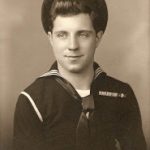 About the author: Joseph B. Chicco. Served as Seaman 1st Class on the USS Mobile.
About the author: Joseph B. Chicco. Served as Seaman 1st Class on the USS Mobile.
About the diary: Published online in 2010 as The 1945 Journal of Joe Chicco in a blog maintained by the writer Elena A. Santangelo. She is the author’s niece.
There are two types of entries: daily entries for a specific date, and data entries for inclusive dates.
Santangelo had this to say, overall, about the physical characteristics of the diary entries:
At the beginning, Joe’s entries were made in blue ink in a small, even script. A neat, straight, red line separated each day and, to define the left margin, he traced another straight red line over the existing first ledger column separation. At intervals of five to ten days, below that day’s entry, Joe wrote in red ink how many days he’d been “out of the states” that year. Also, as they headed west from Pearl, Joe noted time changes in red ink.
On April 8, less than a week after they joined the bombardment of Okinawa, his writing began to lose some of its evenness. He crossed out words for the first time (though he did this rarely). On April 11th, he stopped retracing the left margin ledger line. On the 21st, a few days after an accident in his gun turret, he stopped separating the days with red lines. His handwriting became more of a scrawl.
During May, his grammar got worse and his word order often became confused. Since they were bombarding and fighting off air attacks twenty-four hours a day for weeks, this was likely the result of sleep deprivation.
Conversely, though, his entries regarding the ship’s activities during the Okinawa operation became more and more detailed. Notations included times written in both military and civilian format. Accompanying ships were noted nearly every day.Yet, on May 22, his entries suddenly became very terse. When they left Okinawa he began adding a bit more detail for a few weeks, but from the end of June through early August, he said very little.
September through December’s writings are again more detailed, except when there was, as he put it, “not much doing” on board. After Okinawa, Joe wrote almost nothing about what he did when given liberty or recreation. His main pastime seems to have been watching the other ships.
The Philippine Diary Project only includes the entries written either in Philippine waters or when in the Philippines. From the data section of the diary, these period were:
(Before the diary) September 6, 7, 12, 13, & 14, 21, 22, 1944; October 11, 20 to 27, 1944; November 5 & 6, 11, 13, 14, 25, 1944; December 14, 15, 16, 1944
(In the diary: )
May 16, 28, 31, 1945; June 1, 12, 1945; July 5, 6, 7, 1945; August 1-19, 1945
Readers are urged to obtain Yesterday, Today, and Forever: The World War II Journal of Joseph B. Chicco by Elena A. Santangelo, which is the published version of the diary, and which contains more in-depth information about the diarist and his times:
By February of 1945, Seaman First Class Joe Chicco had already experienced two years of war in the South Pacific. When his ship, the light cruiser U.S.S. Mobile, left port in California and sailed back into action, Joe was already showing symptoms of Post-Traumatic Stress Disorder. This time, though, he packed a blank notebook into his duffle and began to keep a journal. This book includes that journal, and chronicles the history of the U.S.S. Mobile, Joseph Chicco’s life, and the PTSD that plagued him for more than fifty years after the war.